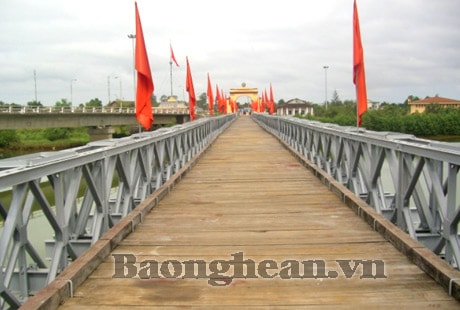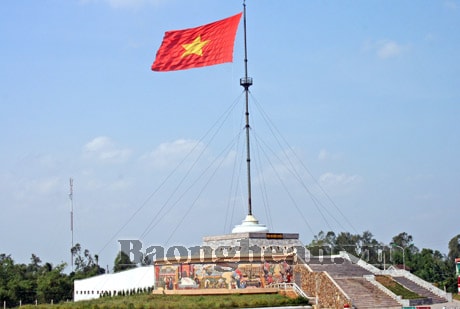Ben Hai River - The pain of separation and the glorious past
Mentioning Quang Tri is talking about a spiritual land, an epic about the feats of arms against the invading American Empire of our army and people written in the heroic land full of white sand and Lao wind. In the historic days of April, from Dong Ha city, we had a journey to Hien Luong bridge over Ben Hai river to see with our own eyes one of the relics that contained the pain of separation between the two regions during more than 20 years of bloody war.
(Baonghean.vn) -Mentioning Quang Tri is talking about a spiritual land, an epic about the feats of arms against the invading American Empire of our army and people written in the heroic land full of white sand and Lao wind. In the historic days of April, from Dong Ha city, we had a journey to Hien Luong bridge over Ben Hai river to see with our own eyes one of the relics that contained the pain of separation between the two regions during more than 20 years of bloody war.
National Highway 1A is as beautiful as a silk strip, taking us to Hien Luong Bridge. Along both sides of the road, there are no longer bomb craters that the enemy dropped; instead, there are houses close together, constructions and green fields. In the distance, Hien Luong Bridge is gradually disappearing before our eyes. So we are about to reach the North bank. Everyone's heart is excited when the lyrics of the song "Ca ho ben bo Hien Luong" from someone's house on the South bank resound: "On the banks of Hien Luong, this afternoon I stand and look back...". It has been 38 years since the country was unified, now listening to those lyrics, the melody seems to still be deeply ingrained in the flesh and blood.

Hien Luong Bridge crosses Ben Hai River today.
Walking on the historic bridge, only a little over a hundred meters long, everyone was filled with a sense of sorrow, because just such a short distance, the people of the two regions had to endure separation for nearly 20 long years. Hien Luong Bridge is like a testament to the enemy's crimes. After the signing of the Geneva Agreement, the country was temporarily divided into two regions, the South and the North, with the 17th Parallel as the temporary military boundary. In this area, throughout the period of separation, Ben Hai River and Hien Luong Bridge were the focus of the intense and fierce struggle between us and the enemy. Many touching and heartbreaking stories took place on both sides of the border. Only a hair's breadth apart, for decades children could not see their fathers, wives could not see their husbands, and relatives on both sides of the river were far apart. Every year, on holidays and Tet, people on both sides flocked to the river wharves to look for their loved ones. Because there were so many people, it was hard to recognize each other, so we had to stand on this side of the river, looking at their clothes and appearance, and secretly guessing "that's my family".
Here, we heard a lot about the tense intellectual battles between us and the enemy. When the bridge was divided in two, a white horizontal line was drawn in the middle of the bridge, 450 planks on this side belonged to the North, the other half of 444 planks were managed by the Saigon Government. Not only did they find every way to sabotage the Geneva Agreement, the enemy also used color to divide the bridge. At first, they painted the southern half of the bridge blue, we immediately painted the other half blue. They then switched to brown, we also painted brown. Just like that, Hien Luong Bridge always changed color, whatever color the enemy painted, we painted this side the same color. In the end, the enemy had to give up, leaving the bridge with only a unified blue color.

The border flagpole - a place that marks the glorious history of the nation.
Next to the historic Hien Luong bridge is a symbol of the whole nation - the border flagpole on the North bank. The history of the border flagpole has also gone through many ups and downs and is associated with the uncompromising fighting spirit of our nation against the invaders. The flagpole is a symbol of the indomitable fighting spirit of our army and people. In 1954-1956, our police officers made a flagpole from a 12m high casuarina tree, with a flag measuring 3.2m x 4.8m. On the South bank, the enemy planted the tricolor flag on the roof of a 15m high bunker, challenging them. At the request of the people on the border, our flag must be higher than the enemy's flag so that they can see it clearly, so the soldiers went into the forest to find an 18m high tree to hang the 24m wide red flag with a yellow star. Immediately after that, Ngo Dinh Diem ordered the erection of a 30m high reinforced concrete flagpole on the South bank. On the top, they hung a large three-striped flag with a system of flashing neon lights of various colors. After raising the flag, the puppet's psychological warfare loudspeakers echoed to the North bank, provoking: "The President of the Republic of Vietnam ordered the erection of a 30m high flagpole at the 17th Parallel so that the people of North Vietnam could clearly see the justice of the Nation."
Unable to let the puppet flag be higher than the red flag with the yellow star, in July 1957, we installed a 34.5m high steel flagpole, with a five-pointed copper star and many light bulbs on top. The flag with an area of 108m2 was raised high, dyeing the entire sky red. At the same time, the people of the North stopped all their farming work to clap and cheer, while the people of the South were so happy and proud that they cried. Completely surprised, the Saigon government hastily raised their flagpole another 5m and loudly challenged: "North Vietnam wants to compete with the flag, but how can it compete with the nation?"
Responding to the people's wishes, we raised the flagpole to 38.6m high, and on top hung a large flag with an area of 134m2 and weighing 15kg. Despite mobilizing hundreds of planes and using tens of thousands of large-caliber artillery shells, the enemy still could not erase the sacred red flag with yellow star at the North of Hien Luong Bridge. On August 2, 1967, the enemy used many groups of planes to break the flagpole and collapse Hien Luong Bridge. But that very night, our brave soldiers carried explosives to break the flagpole on the southern bank, ending the three-striped flag forever in the sky above the border line. At the same time, with a wooden pole attached to it, our flag fluttered in the early morning sun, making our compatriots happy... The border line flag is a symbol of the North always standing by the compatriots of the South in the struggle, despite the hardships and difficulties, despite the many painful losses, but firmly believing that one day the country will be unified, as President Ho affirmed: "The South is the blood of Vietnamese blood, the flesh of Vietnamese flesh. Rivers may dry up, mountains may wear away, but that truth will never change."
From May 19, 1956 to October 28, 1967, the border soldiers hung a total of 267 large flags, 11 times raising the flags on wooden poles 12-18m high, 42 times changing the flags because they were damaged by bombs. In order for the national flag to fly at the border, many soldiers heroically sacrificed their lives, many selflessly protected the national flag. Every time the flag was pierced by a bomb, another flag was immediately raised so that the spirit of the Fatherland would always fly in the sky of Vietnam. In 2001, at the old location, a new flagpole 38.6m high was erected, modeled after the 1962 design. Below the flagpole was built a majestic flagpole with many reliefs expressing the aspiration for unification, the joy when North and South reunited.
Standing still between the two banks, looking at the Ben Hai River, a gentle, poetic river that for a long time had to bend as a dividing line between Vietnam. The pain of separation is like a harsh fate. There are few places where the war took place as fiercely, fiercely, in many forms as here. In 1996, a new concrete bridge was built to meet the requirements of traffic development in the new period and replace the old, degraded bridge. The historic Hien Luong Bridge is still preserved next to it.
Every day, people and vehicles crowded across the bridge. It seemed like everyone looked back at the historic bridge, then looked up at the national flag fluttering on the flagpole of the border to remember, and then could not forget a painful but heroic time. Ben Hai - Hien Luong in the painful, fierce, smoky and ruined past, today it is known by people everywhere as a heroic historical relic, a spiritual land.
For us – the later generations of Vietnamese, even though we have only been to this place once, we still believe that time can fade everything but cannot erase the image of “A time of fire and flowers on the old battlefield”. Because that is an immortal heroic epic written by our army and people in the heroic land of Quang Tri. Ben Hai – Hien Luong embraces the spirit of patriotism, pride and indomitable will of the nation.
Le Khac Nien - No. 2 - Yet Kieu - Ward 5 - Da Lat - Lam Dong






